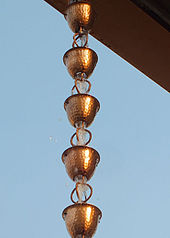Rain chain

Rain chains (Japanese: 鎖樋, kusari-toi or kusari-doi,[1] literally "chain-gutter") are alternatives to a downspout. They are widely used in Japan. Their purpose is largely decorative, to make a water feature out of the transport of rainwater from the guttering downwards to a drain or to a storage container. (Rainwater is sometimes collected for household usage.) They can also be found on temples.[2]
Rain chains are typically either a series of metal cups, chained together with a hole in the bottom of each, or chain links that span vertically.[2] Rain water run-off gets distributed from a rooftop gutter downward through the rain chain.

Rain chains have also been used in the West. Nordic vernacular architecture often used a simple stick as a rainwater guide, in similar fashion. They have also been used in the Modernist era, to juxtapose metal chains with a concrete or Portland stone facade. They are often seen in cup-shape, link and loop style, as well as decorative.[3]
References
[edit]Further reading
[edit]- Pleasant, Barbara (2006). "Make a Rain Chain". Easy Garden Projects to Make, Build, and Grow: 200 Do-It-Yourself Ideas to Help You Grow Your Best Garden Ever. Emmaus, Pa.: Rodale. p. 147. ISBN 9780899093994. OCLC 62782168.

